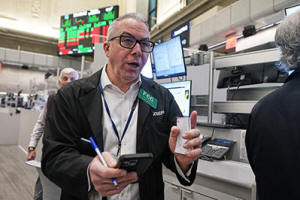Wall Street rises to the edge of its all-time high
[December 06, 2025] By
STAN CHOE
NEW YORK (AP) — The U.S. stock market rose to the edge of its all-time
high on Friday.
The S&P 500 added 0.2% and finished just 0.3% shy of its record closing
level, which was set in October. It had briefly topped the mark during
the day, before paring its gain.
The Dow Jones Industrial Average added 104 points, or 0.2%, and the
Nasdaq composite gained 0.3%.
The modest moves capped a quiet week for Wall Street, offering a respite
following weeks of sharp and scary swings.
Ulta Beauty helped lead the market and jumped 12.7% after the retailer
reported stronger profit and revenue for the latest quarter than
expected. CEO Kecia Steelman said its customers are broadly feeling
pressure, but Ulta saw growth across its categories, particularly in
e-commerce. It raised its forecast for revenue over the full year.
Another encouraging signal for the holiday shopping season came from
Victoria’s Secret & Co. It delivered a milder loss for the latest
quarter than analysts expected, and it likewise raised its forecast for
sales over the full year. Its stock rallied 18%.
Warner Bros. Discovery rose 6.3% after Netflix said it would buy Warner
Bros. for $72 billion in cash and stock following its pending split from
Discovery Global.
The deal for the company behind HBO Max, “Casablanca” and “Harry Potter”
is not a sure thing, though. It could raise fears at the U.S. government
about too much industry power residing at Netflix.

Shares of Netflix fell 2.9%. Paramount Skydance, which earlier had been
seen as a front-runner to buy Warner Bros., sank 9.8%.
Also on the losing end of Wall Street was SoFi Technologies. The
financial technology company fell 6.1% to $27.78 after saying it would
add $1.5 billion worth of its stock into the market in order to raise
cash. It’s selling the stock at a price of $27.50 per share.
All told, the S&P 500 rose 13.28 points to 6,870.40. The Dow Jones
Industrial Average added 104.05 to 47,954.99, and the Nasdaq composite
gained 72.99 to 23,578.13.
If the S&P 500 does return to a record, it would mark the latest time
the U.S. stock market has powered past what seemed to be a debilitating
set of worries. Most recently, those concerns centered on what the
Federal Reserve will do with interest rates, whether too many dollars
are flowing into artificial-intelligence technology and if sharp drops
for cryptocurrencies would bleed over into other markets.
[to top of second column] |

Options trader Joseph D'Arrigo works on the floor of the New York
Stock Exchange, Tuesday, Dec. 2, 2025. (AP Photo/Richard Drew)
 After some back and forth, the
widespread expectation among traders is now that the Fed will cut
its main interest rate next week in hopes of shoring up the slowing
U.S. job market. If it does, that would be the third cut of the
year.
Investors love lower interest rates because they boost prices for
investments and can juice the economy. The downside is that they can
worsen inflation, which is stubbornly remaining above the Fed’s 2%
target.
Economic reports released on Friday did little to change
expectations for a coming cut. One said that an underlying measure
of inflation that the Fed prefers to use was at 2.8% in September,
exactly as economists expected.
A separate report said U.S. consumers appear to be downgrading their
expectations for inflation coming in the near future. They’re now
forecasting 4.1% inflation for the year ahead, down from their
forecast of 4.5% last month, according to the University of
Michigan.
That’s the lowest such forecast since January, which is important
because heightened expectations for inflation can create a vicious
cycle that only worsens inflation.
In the bond market, Treasury yields climbed. The yield on the
10-year Treasury rose to 4.13% from 4.11% late Thursday.
In stock markets abroad, indexes were mixed in Europe and Asia.
Germany’s DAX returned 0.6%, and South Korea’s Kospi jumped 1.8% for
two of the world’s bigger gains.
Tokyo’s Nikkei 225 fell 1.1% after data showed household spending in
Japan fell 3.0% in October from a year earlier. It was the sharpest
drop since January 2024. Japanese markets have been shaky recently
after the Bank of Japan hinted that hikes to interest rates may be
coming.
___
AP Writer Teresa Cerojano contributed.
All contents © copyright 2025 Associated Press. All rights reserved |